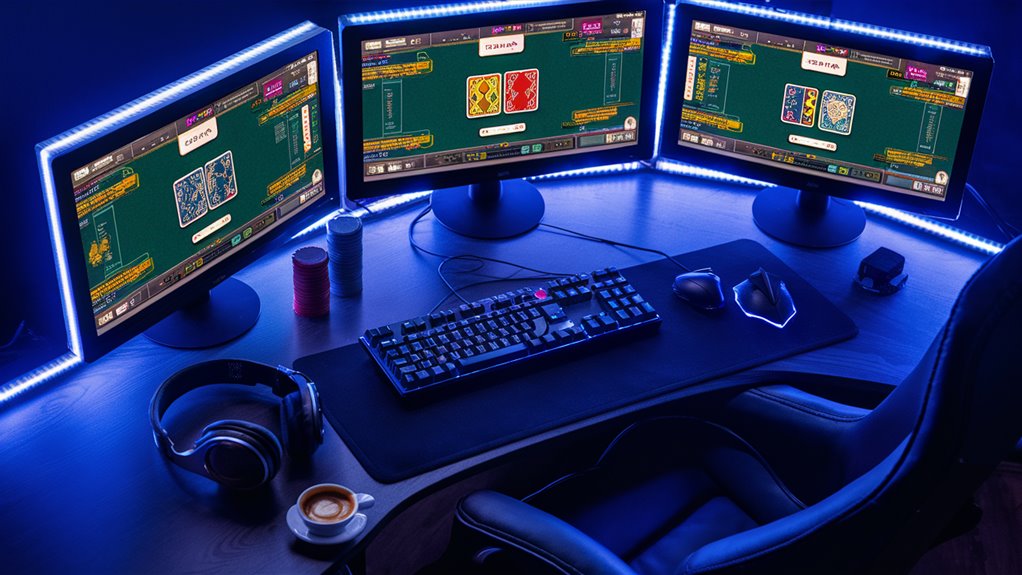How to Win in Online Poker Games

Choosing Your Games Smartly
Good cash planning is key to playing online poker well. Have at least 100 buy-ins for the cash you play with to last longer and keep safe from big swings. Pick games that suit your skill and budget, eyeing the ones with the highest return (ROI).
Wise Game Strategies
Start with a careful, strong approach when the game starts, and blinds are small. As blinds grow, play more boldly to keep up. Your seat matters — pick a good spot to gather chips using smart moves and right timing.
Leverage Technology
Use poker tools and HUDs to grasp how your foes play. Set up your screens and key shortcuts right. This tech aid lets you make better moves as the game rolls on.
Stay Sharp
Stay alert by taking short breaks every hour. Set strict loss limits and stick to them always. To win, you need full focus and to keep calm, mainly in long rounds.
Master Advanced Skills
Get better at end game plays and small-table games. Know when game phases shift. Mastering these skills leads to more wins.
Always Improve
Review past games, think on your moves, and switch up your play based on your findings. Join communities to study poker and use training sites. To excel at online poker, always aim to get better.
Finding the Best Game Type: Full Guide
Understanding Various Game Styles
Online poker games come in many shapes. Each type needs certain skills, time, and cash planning.
Match the game type to your style, time, and what you can afford to lose.
Good Games for Beginners
Sit-and-go games (SNGs) are great for newbies. These games have:
- Set costs and player counts
- Known game length
- Simple learning
- Less swings in wins and losses
Playing Large Tournaments

Multi-table games (MTTs) can give big prizes. They feature:
- Large rewards
- Deep gameplay
- Advanced strategies
- Long playtime of 4-8 hours
Quick Games
Turbo and hyper-turbo games fit those wanting quick matches. They offer:
- Rapid blind levels
- Smaller starting stacks
- Quick decisions needed
- Brief game times
More Exciting Games
Knockout games push you to play bold for:
- Instant rewards for knockouts
- More exciting play styles
- Gaining Popularity Worldwide
- Additional layers in the game
- More fun to watch and join
Games for Bigger Wins
Qualifying games offer a shot at big events by:
- Lower cost for major matches
- Distinct play styles
- Opportunity to build funds
- Steps to larger matches
One Shot vs. Multiple Attempts
Choosing your game type impacts potential earnings by:
- One shot or multiple chances
- Type of rewards
- The kind of players
- How you plan your cash
Building Your Poker Money: Top Strategy
Creating Your Poker Fund
Good cash management is essential for success in poker.
The vital 100 buy-in rule suggests you should have funds that are 100 times your regular game cost. This strategy keeps you safe from big swings and aids growth.
Begin Small and Climb Up
Start with small cash games to stick to the 100x cash rule.
A $500 fund works well with $5 game costs. This way, you can move up safely as you win more.
Track Wins and Losses
Keep a detailed record of your game results, using a list or ledger.
Note your returns (ROI) across different games and forms. This info shows where you perform best.
Factor in the game cost when evaluating performances 안전놀이터
Protect Your Fund
Be cautious with your fund growth. Don’t rush to higher games too soon.
Prove you can win at your current level before moving higher.
If times get tough, step down to safer games to protect your cash. This careful approach guarantees you can keep playing for a long time.


